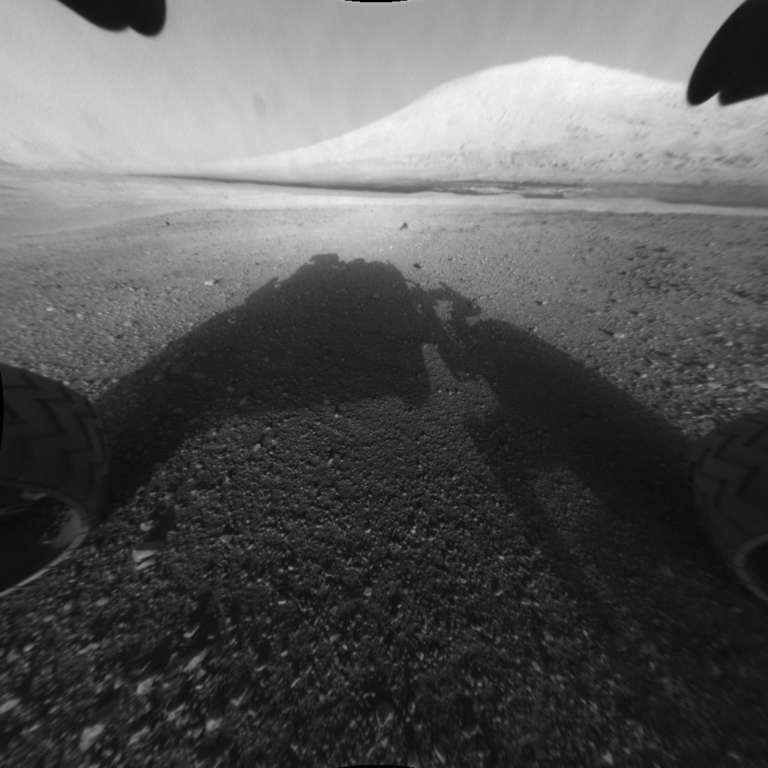Emily Lakdawalla • Aug 06, 2012
Curiosity: Notes from the two day-after-landing press briefings
This is just insane. The Internet is still totally exploding over what happened yesterday.
I'll try not to add redundancy to the chatter and just hit high points. And boy, were there high points at today's press briefings, one of them held at 9:00 a.m. and one at 4:00 p.m., Pacific time. I stayed at JPL all night before attending the morning one; I had had a meal, a brief nap, and a shower before the afternoon one. I've posted the amazing HiRISE photo of Curiosity descending (both the spacecraft and its heat shield), and the equally amazing video from the MARDI camera. Now for just some plain facts, and the best-available version of the rover's forward view from landing day:

Some details on the physical state of the rover:
- Facing east-southeast. She's sitting very flat, tilting very slightly at -3.6 degrees. Left side down 2 degrees relative to right side.
- She went slightly long in her ellipse, about 2 kilometers downrange, and a few hundred meters to the north.
- She's 6 kilometers from the mountain, and 28 from the crater rim.
- All science instruments have checked out healthy.
- As is their wont, the press kept pushing to find out if anything was going wrong. The simple answer: No.
- The first couple of communications passes resulted in 5 Megabits of data. After today's communications passes, they now have 40 Megabits on the ground.
- Malin reported the following landing coordinates based on analysis of the MARDI images: -4.5895 S, 137.4417 E
Some details on plans for the coming sols: (I have very poor notes on this. Has anybody out there collected the scattered comments on what activities are planned for when?)
- Today: Deploy High-Gain Antenna, track Earth with it. Perform daytime observations with RAD, the one science instrument that was operating throughout cruise (the radiation detector). Perform daytime observations with REMS, the weather monitoring instrument. Take a photo with MAHLI, the hand-lens imager, which is currently looking over Curiosity's left shoulder so should have a view of the northeast rim of the crater. Carefully study how the rover changes temperature with the day-night temperature cycle overnight.
- There's a navcam panorama coming up. Mastcam-34 (the medium-field color camera) panorama will be taken on sol 4, with thumbnails sent down first.
Some very, very early commentary from John Grotzinger on science:
- We think we've landed very close to the edge of the alluvial fan (a deposit of sediment that has been washed down from the high-standing rim of Gale crater).
- The science team is impressed by the uniform grain size distribution of the pebbles. (Malin describes it as a lag deposit, meaning that finer material has been blown away by wind, leaving gravel behind.)
- The geology appears fairly simple to interpret at the spot where Curiosity landed, a good place to begin with a complex mission.
- Grotzinger told a funny story, about how, before landing, the science team (406 of them!) were presented with the opportunity to choose whether to have the rear or forward facing hazcam image come down first. The engineers assumed the scientists would want the front haz view, which would be less obstructed by hardware. The scientists said, no way, that first image is not about science; it's about seeing wheels on the dirt. So show us an image that contains more hardware. This isn't the first time on this mission that the engineers have been thinking more like scientists and the scientists more like engineers.
Some other random facts:
- The descent stage could have departed the rover in one of two directions: forward, or backward. It was deliberately commanded to go whichever of these directions was more north, since that would take it farther from the direction the rover was likely to drive. Since the rover is facing east-southeast, that means it flew to the back, to the west-northwest.
- Mars Exploration Rover communication sessions were scheduled at the same Mars time every day because much of its early data came through a direct-to-Earth X-band link, not requiring an orbiter. Curiosity generates so much more data than Spirit and Opportunity did that orbiter relay is required to keep up with it all. Orbiter relays can only happen when orbiters pass above the horizon. That generally happens twice a day, separated by about 12 hours, give or take an hour and a half, which messes with the schedule.
- There is not expected to be competition for communications sessions with orbiters between Opportunity and Curiosity.
The next briefing is scheduled for tomorrow at 10:00 a.m. PDT (17:00 UTC). I plan to be at JPL for that one.
Let’s Go Beyond The Horizon
Every success in space exploration is the result of the community of space enthusiasts, like you, who believe it is important. You can help usher in the next great era of space exploration with your gift today.
Donate Today

 Explore Worlds
Explore Worlds Find Life
Find Life Defend Earth
Defend Earth

